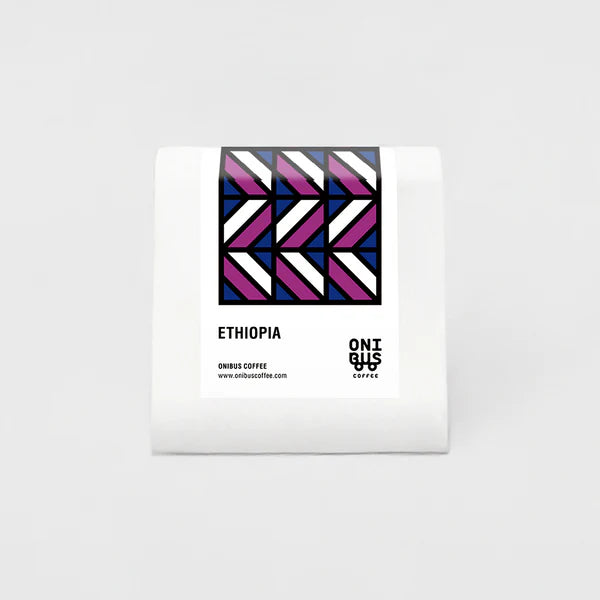ONIBUS COFFEE
ONIBUS - Worka Sakaro "Lot. Bire" | Ethiopia - Washed - Heirloom 200g
ONIBUS - Worka Sakaro "Lot. Bire" | Ethiopia - Washed - Heirloom 200g
 Origin: Ethiopia
Origin: Ethiopia
 Tasting Notes: White Grapefruits, Floral, Cane Sugar, Smooth Mouthfeel
Tasting Notes: White Grapefruits, Floral, Cane Sugar, Smooth Mouthfeel
 Process: Washed
Process: Washed
 Varieties: Heirloom
Varieties: Heirloom
 Producer: 25 small farmers
Producer: 25 small farmers
 Farm: Worka Sakaro
Farm: Worka Sakaro
 Region: Gedeb, Gedeo zone, East of Yirgacheffe
Region: Gedeb, Gedeo zone, East of Yirgacheffe
 Elevation: 2050 masl
Elevation: 2050 masl
 Recommended Brew: Filter
Recommended Brew: Filter
 Roast Date:
Roast Date:
Couldn't load pickup availability
Onibus Coffee is located in Tokyo, Japan
From ONIBUS
Introducing the local trader BNT CEO Bille's Selectlot from Ethiopia. The Gedeo Zone in the eastern part of the Yirgachefe region is divided into six districts, one of which is the Gedeb district. The Gedeb district is divided into 16 administrative districts, one of which is the Wolka Sakaro district.
The two company presidents, Bile and Teddy, first gained experience in the coffee business at another company, and then invited his classmate from Addis Ababa University, Bile (who was working in international development at the time), to establish BNT. Since then, their motto has been "PAY FAIR GET FINNEST". We
started working with them in 2012. BNT's Yirgacheffe coffee is fresh and of excellent quality, and while interacting with the two presidents, Bile and Teddy, at the production site, exhibitions in Japan and overseas, I was impressed by their attitude of always listening to customer opinions and making improvements. I also liked how they love visiting customers and drinking coffee. In the early days of the company, the quality was not that good, and they seemed to have difficulty with financing.
However, they have made improvements step by step with their customers to get to where they are today. The company has exclusive contracts with 45 washing factories in Yirgacheffe, Sidamo, Guji, etc. to procure coffee, and also owns several washing factories as subsidiaries. Advance payment to farmers (before harvest) via a washing factory, harvesting of fully ripe beans, proper washing process, slow drying, and precise sorting at the company's own threshing and refining factory all lead to high quality, unique coffee. In order to further reduce the rate of defective beans mixed in at the refining factory, a color sorter has been added, and the factory is currently under construction to expand in order to improve space and production efficiency.
Mr. Ville enjoys interacting with people and has a sense of humor and art. This time, we will deliver a lot selected by President Ville from the many lots of Gedeb Wolka.
Production process:
1. Cherries with good ripeness are put into the tanks of the factory.
2. Cherries are peeled with a Mackinnon disc pulper, and the parchment is gravity-sorted into P1, P2, and P3 by water flow (P1 is the heaviest and highest grade).
3. The parchment is led to the fermentation tank, where it is fermented for about 36 to 48 hours.
4. When the slippery surface peels off from the parchment, it is washed with water in a waterway.
5. After about half a day of soaking, the parchment is drained and dried in the sun on an African bed
. 6. The parchment is stirred and defects are removed, and the drying is completed over 12 to 15 days.
7. After dry milling at the threshing factory, the beans are refined, impurities are removed, shelled, gravity-sorted, and hand-picked, and the final refined raw beans are filled into burlap bags and exported
. During the hours of 11:00 to 15:00 when the sun is strongest, the parchment is covered with a vinyl sheet. This is to protect the parchment and prevent it from drying too quickly. In this region, which is located at a high altitude and directly under the equator, too much sunlight can damage the cherries and parchment, resulting in a cloudy taste.
In addition, instead of the usual 8 days of drying, slow drying is carried out over 12 to 15 days, which homogenizes the moisture in the coffee and creates a complex yet clean taste. It has been found that slow drying has a significant impact on the shelf life of green beans in consuming countries.
After drying, the green beans are threshed and sorted by machine and then hand-picked to complete high-quality FW coffee. The method is simple, but the quality is greatly influenced by human effort.
The Gedeo Zone on the east side of the Yirgachefe region is divided into six districts, one of which is the Gedeb district. It is 434 km away from the capital Addis Ababa, and until a few years ago it was a remote area that took nearly 8 hours by car, but with the opening of the Ethio-Kenya Highway in 2016, the travel time has decreased to about 3 hours. This region is one of the best places for coffee production in Ethiopia, with coffee planted on 1/4 of the land. The Gedeb region is divided into 16 administrative districts, one of which is Wolka Sakaro.
The steep slopes and dense greenery make it ideal for natural cultivation, and there are many Horus banana trees around the coffee trees, so the leaves fall, decompose, ferment, and become compost, increasing the amount of nitrogen and enriching the soil.
The name of the washing plant, Wolka, means "gold" in the local Gedeo language, but when a subordinate of Ethiopia's last emperor, Haile Selassie, visited this area, he was so impressed by the hospitality of the people that he came to call this area Wolka (the land of gold).
The Wolka Sakaro washing plant was started by BNT's subsidiary Ranger (employees wearing the green uniforms in the photo) from the 2019 crop, with the aim of making the best Yirgacheffe ever.
We gather excellent staff at a reasonable wage and carefully carry out the refining and drying processes.
(Reference: Importer's materials)
Share


